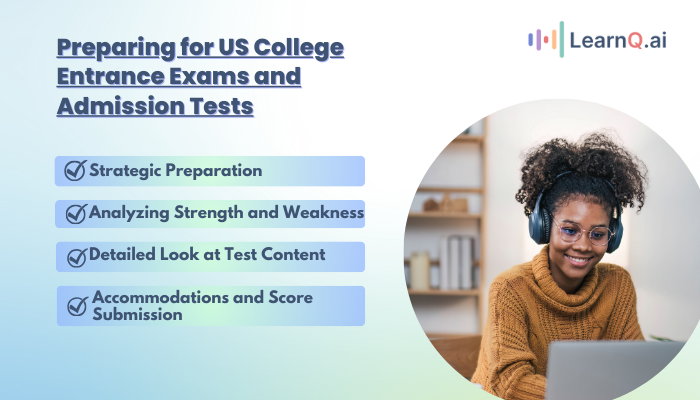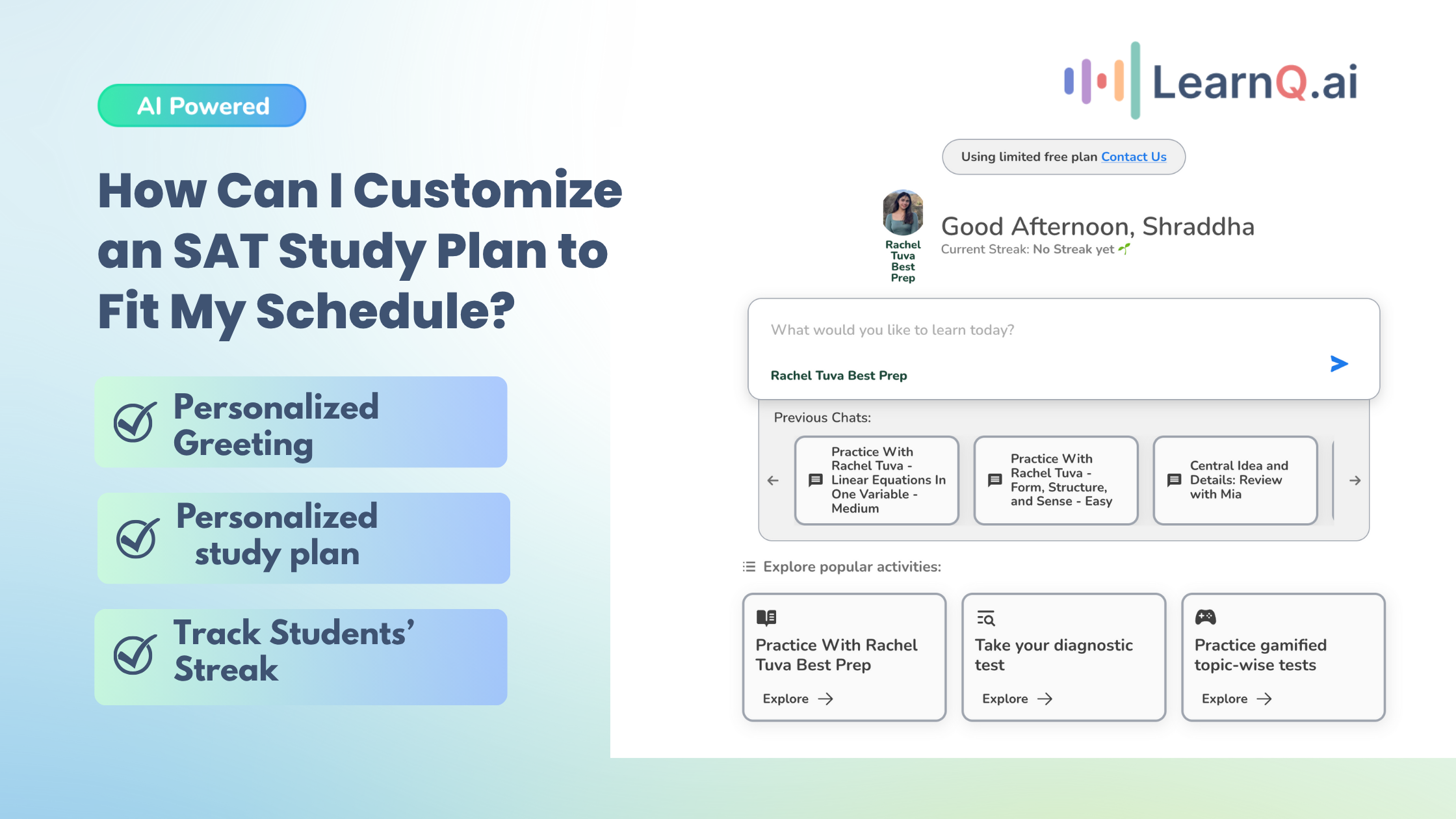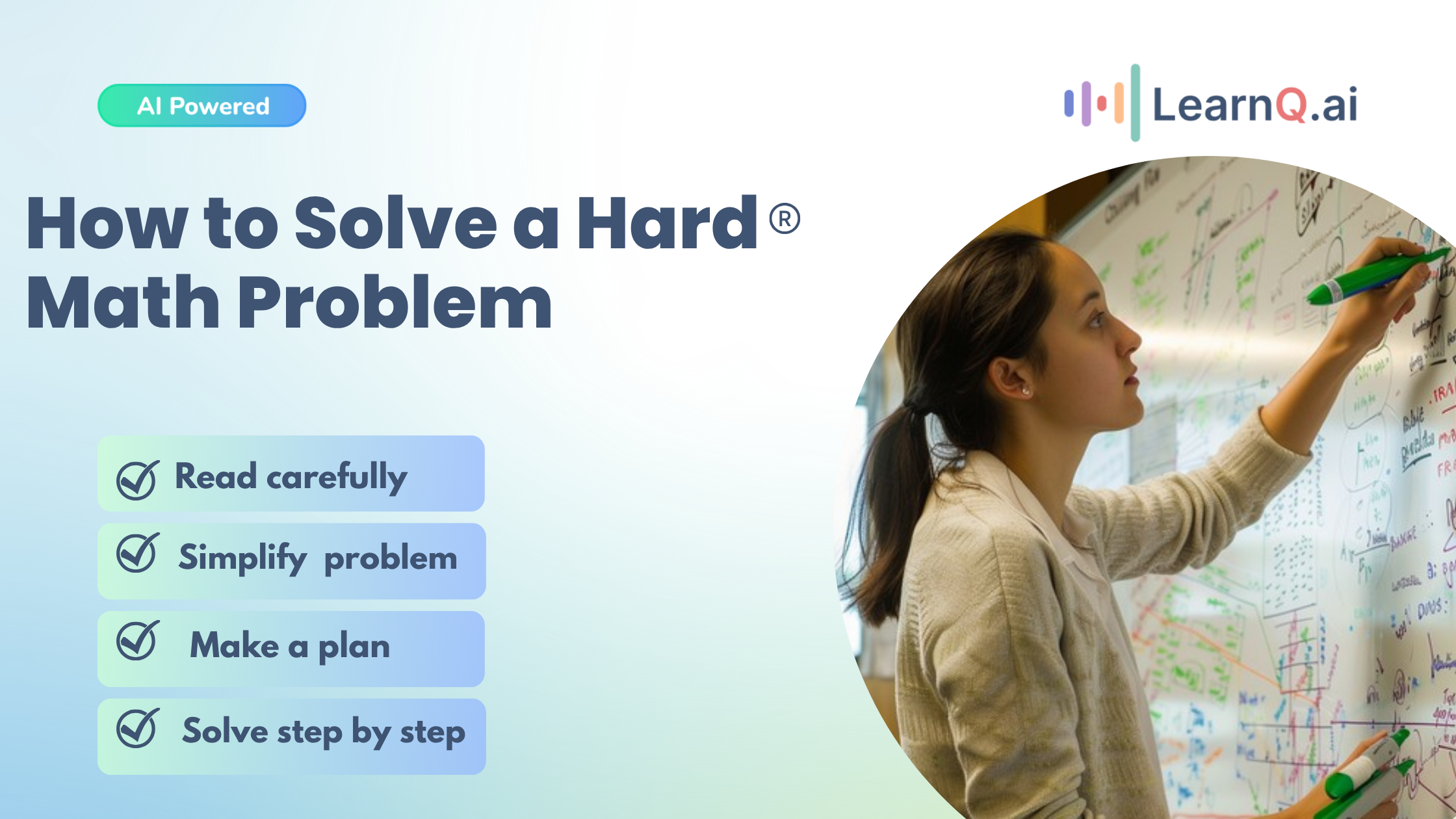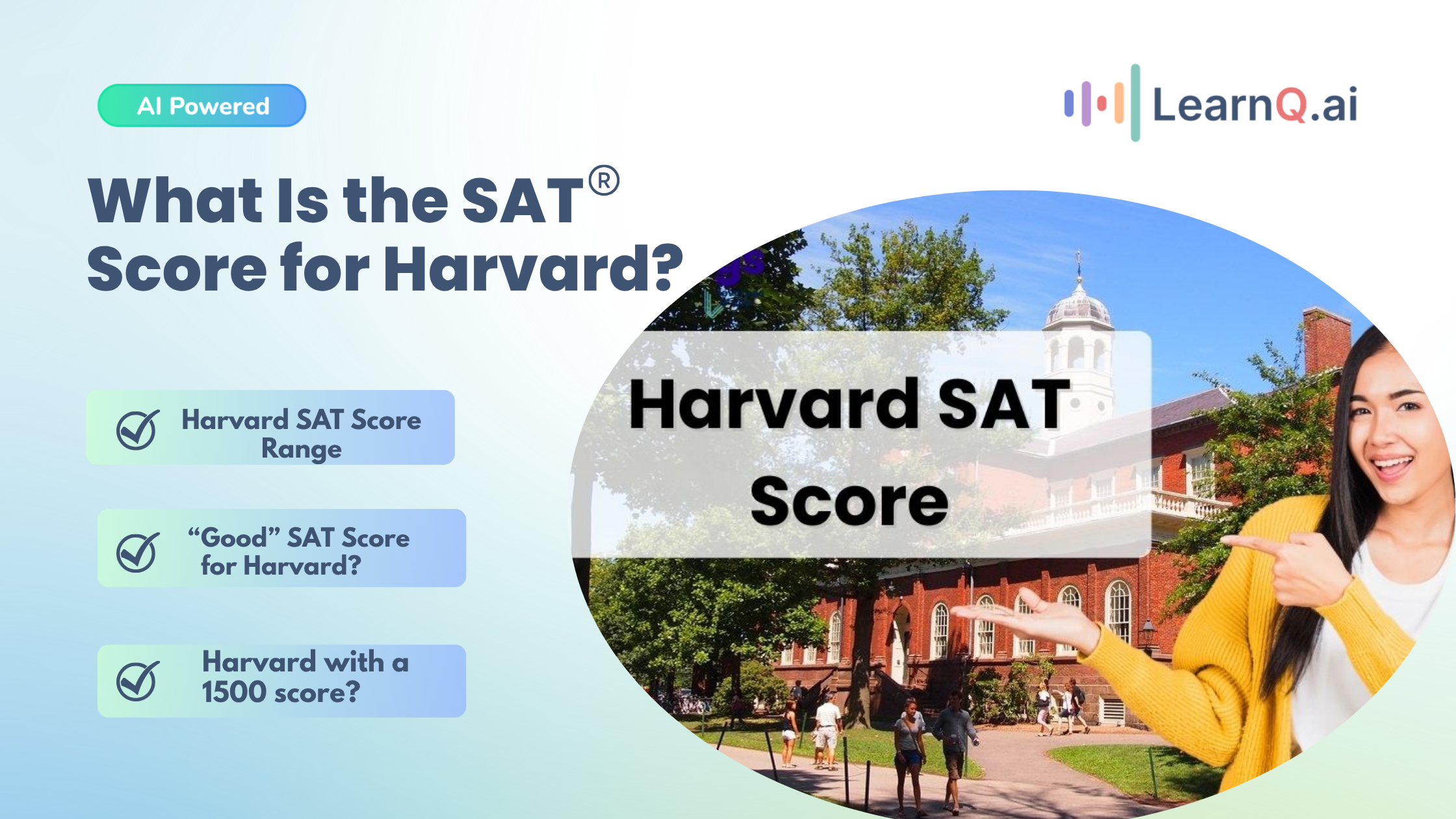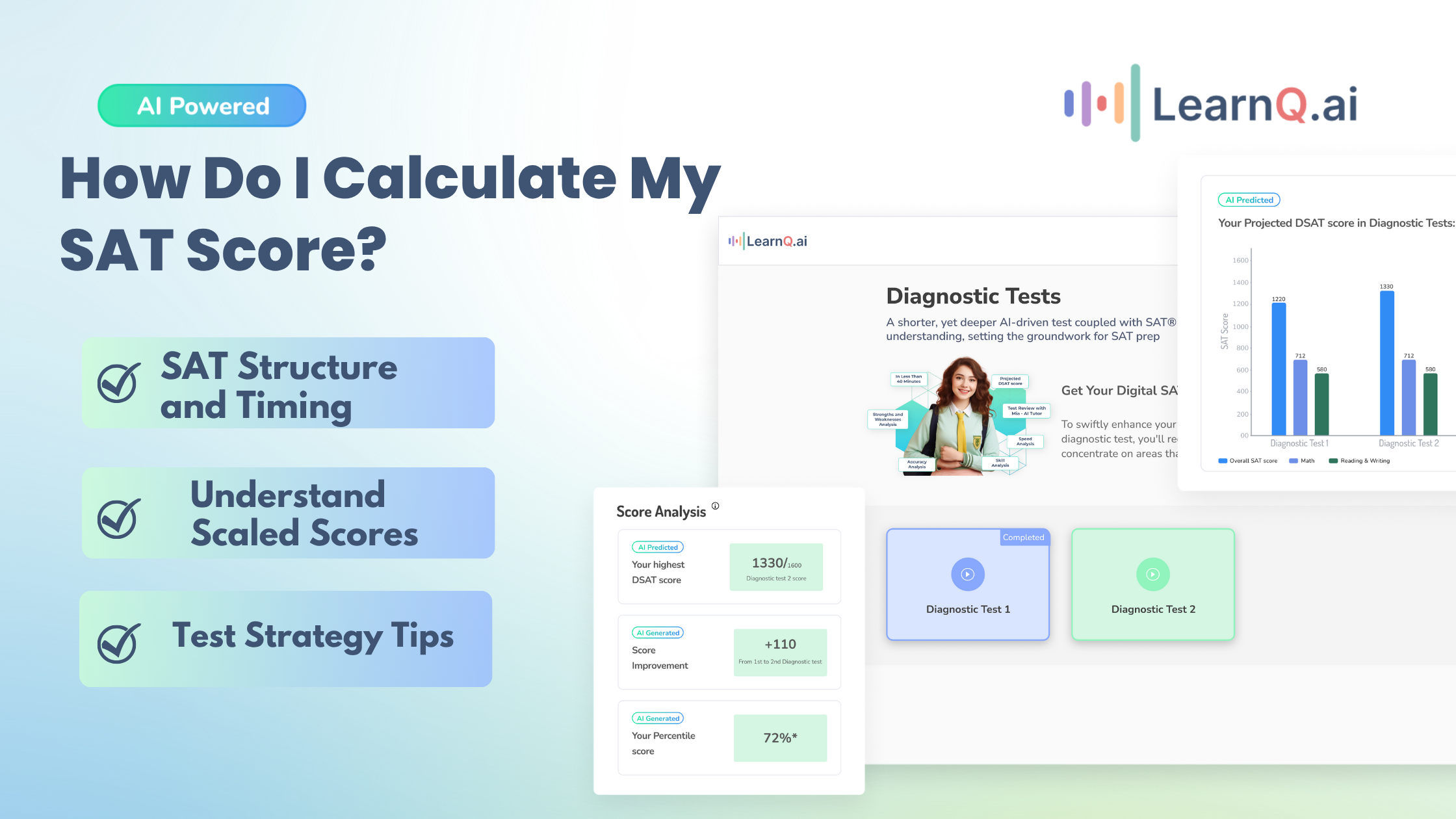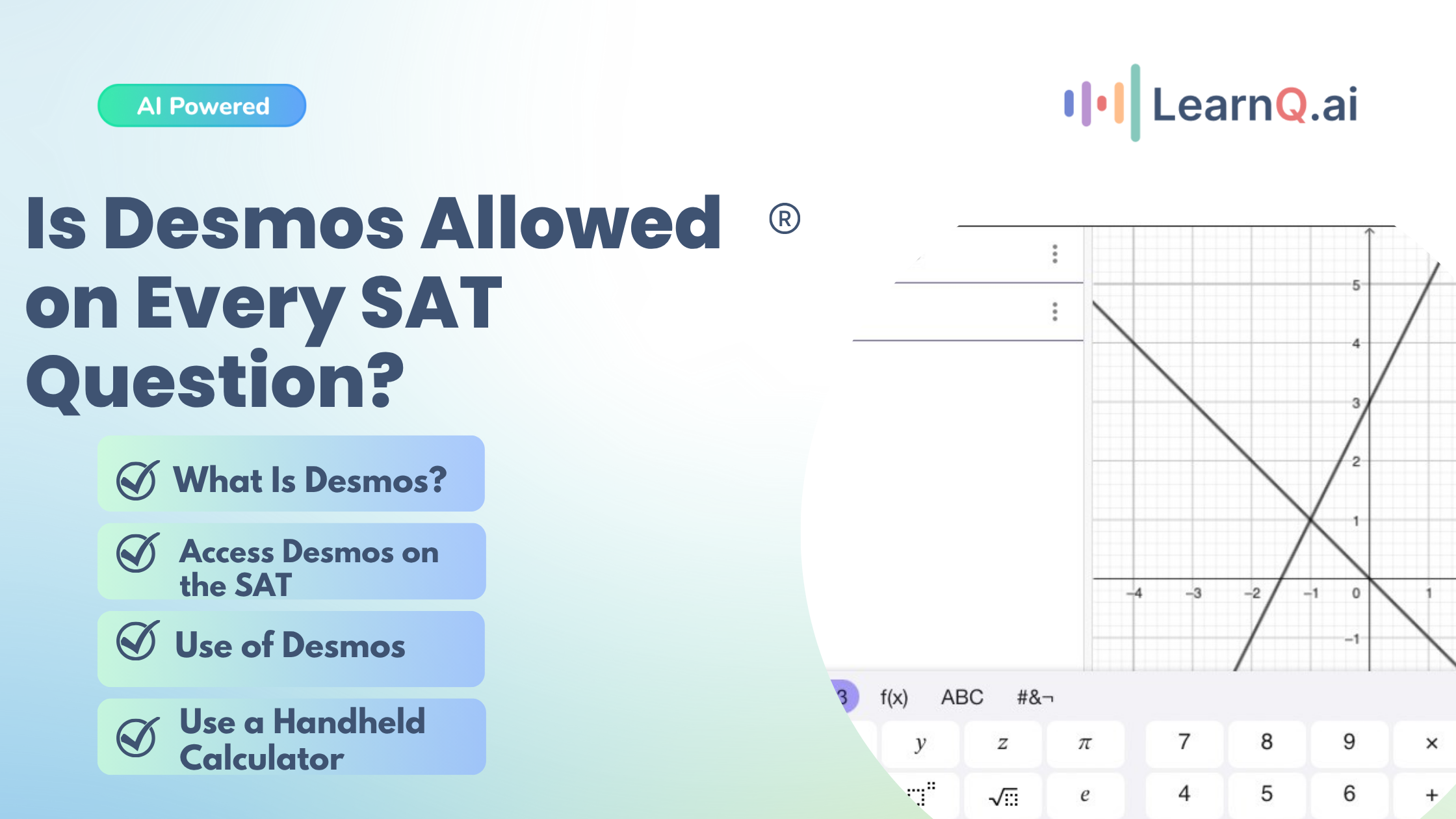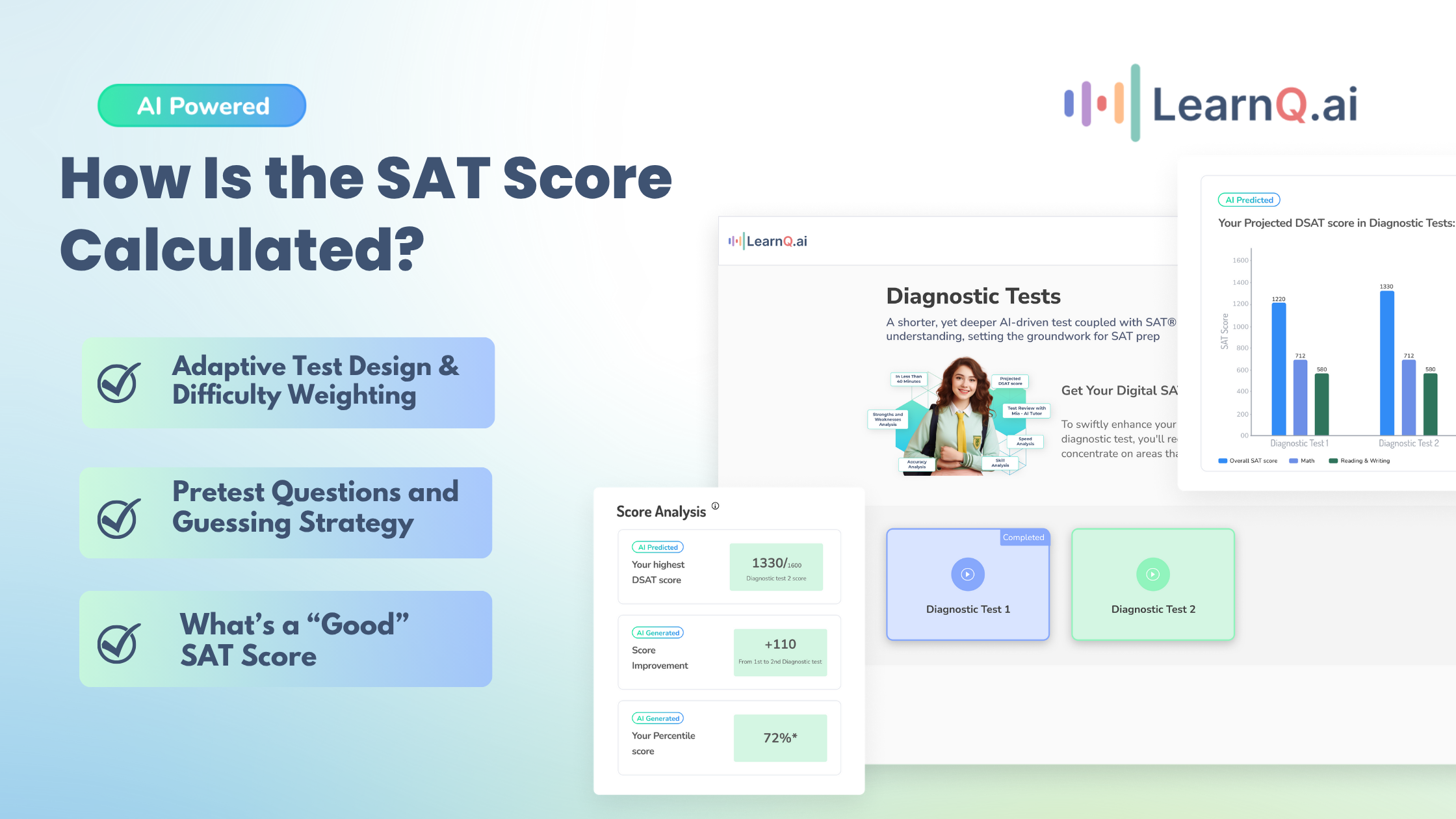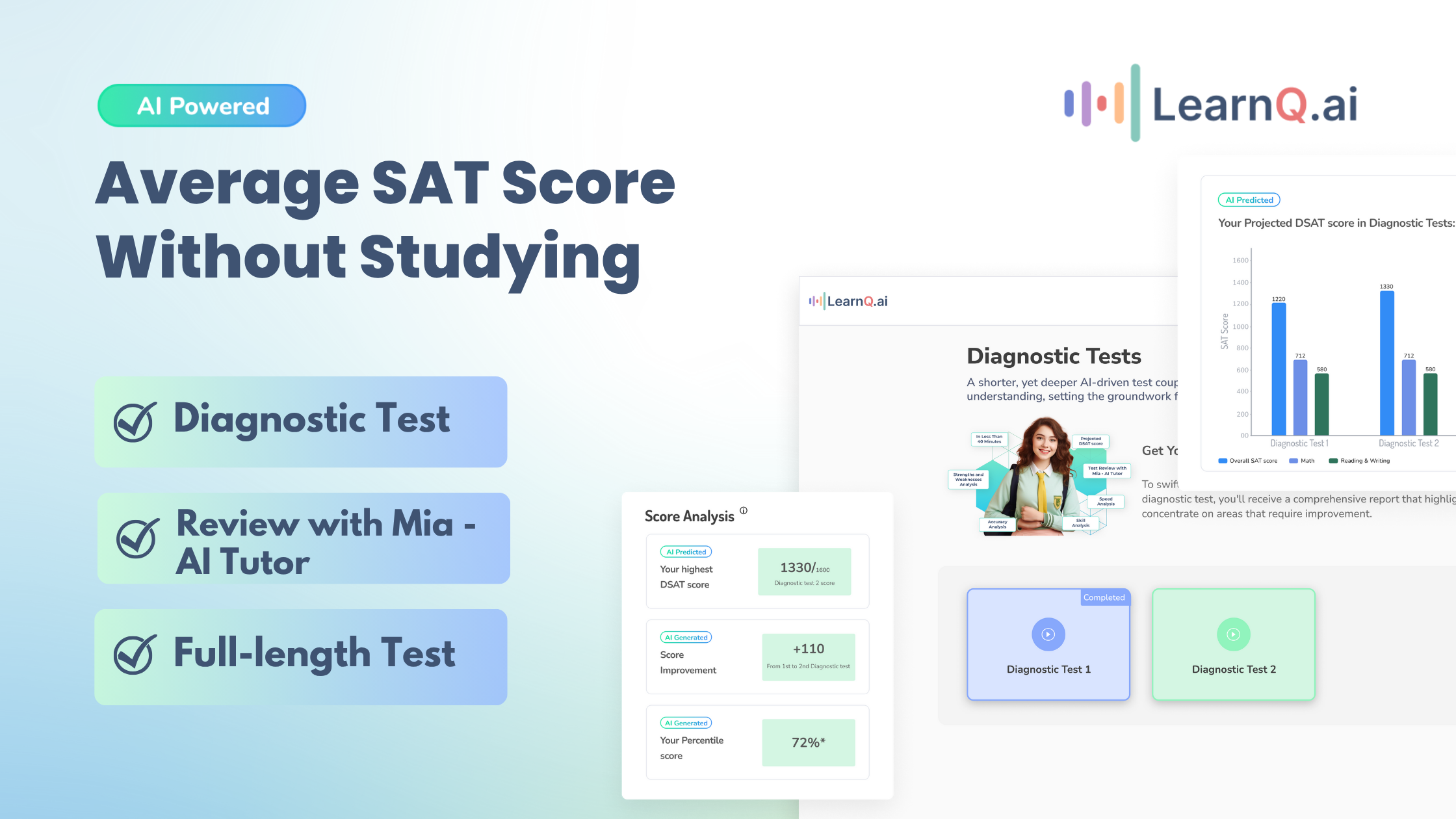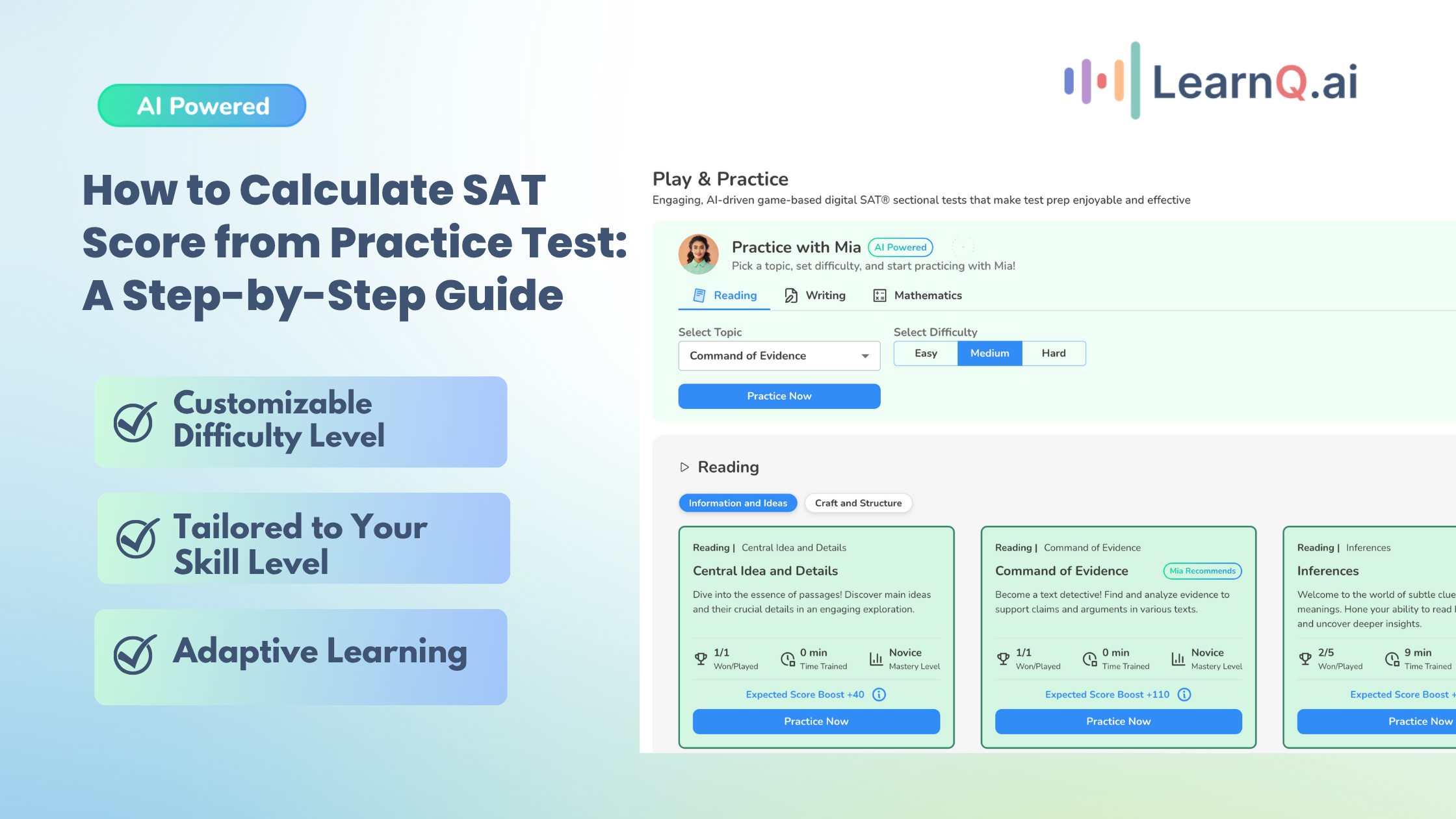Every year, almost three million students take the SAT as part of their college admissions process in the US. This test helps colleges assess whether students are academically prepared for college-level coursework. Students may also take other tests, like the PSAT, which is designed to help them prepare for the SAT while offering opportunities for scholarships.
Online platforms like LearnQ make test preparation simpler and more effective for both students and tutors. It offers personalized tools and in-depth analytics that support individual learning needs.
LearnQ.ai is Powered by VEGA AI—Is your Institute Next?
Give students a Duolingo-style test-prep platform with Shopify-level customization for tutors and institutes.
In this article, you will learn about standardized tests in college admissions and tips for preparing for the SAT and ACT.
Overview of Major College Entrance Exams
College entrance exams elevate applicants from different high schools and locations. Below are the two popular entrance exams:
1. SAT (Scholastic Assessment Test)
The SAT is used to evaluate high school students for college admissions. It measures skills important for college success, such as reading comprehension, writing ability, and math skills.
2. ACT (American College Test)
The ACT is used to assess students’ readiness for college. It measures what students have learned in school and how well they can apply it.
PSAT (Preliminary SAT)
The PSAT, or Preliminary SAT, is a practice test for the SAT. Students usually take the PSAT in 10th and 11th grades, but you can only take it once a year. The PSAT is 2 hours and 45 minutes long, testing your reading, writing, and math skills.
Enhance your Digital SAT study routine with AI-driven insights and personalized practice tests.
Choosing Between Colleges Tests: SAT and ACT
The SAT and ACT are popular entrance exams, but they differ. Here’s a comparison to help you better understand them and decide which to take.
| Factors | SAT | ACT |
| Duration | 2 hours 14 minutes | 2 hours and 55 minutes without an essay2 hours 40 minutes with essay |
| Time per question | 1 minute 22 seconds | 49 seconds |
| Exam Structure | Reading + WritingMathematics | EnglishReadingMathematicsScienceEssay (Optional) |
| Test Score | 400-1600 | 1-36 |
| Mathematics Syllabus | Algebra I and IIGeometry and TrigonometryArithmetic/Probability/Data Analysis | Algebra I and IIGeometry and TrigonometryArithmetic/Probability |
| Reading Syllabus | 5 Reading Passages | 4 Reading Passages |
| English Syllabus | Grammar/PunctuationVocabularyEditing skills | Rhetorical skillsGrammar/PunctuationSentence Structure |
| Frequency of Test | 7 times a year | 14 times across 7 months |
| Test Cost | USD 130 | USD 185 (without writing)USD 209 (with writing) |
Learn about SAT exam eligibility by exploring the age limit qualification and minimum core required.
Registration and Testing Guidelines
Follow the below step-by-step guide for a smooth registration process:
STEP 1: Visit the official college website and create an account. Make sure your account name matches your photo ID on test day.
STEP 2: Select the preferred test date and testing center.
STEP 3: Enter the details of the high school you attended. This will help the organization to understand the educational background and facility score reporting.
STEP 4: Upload your recent photo. This photo will appear on your admission ticket.
STEP 5: Connect with college search services offered by both organizations to help you find colleges and scholarship opportunities that match your profile.
STEP 6: Pay the registration fee for the test you are applying for.
STEP 7: After registering, print your Admission Ticket and keep it with a valid photo ID for test day.
Writing Section: Is It Worth It?
Some colleges require a writing section, while others do not. It is important to check the admission requirements for your interested schools. A good writing score can improve your application by showing your communication skills. If you have time to prepare, it’s worth taking the writing section, even if it’s not mandatory.
Best Time to Take the Tests
The best time to take your SAT or ACT is late in your junior year. This gives you a chance to:
- See how you do: Your first test is like a practice run. It helps you understand what areas you need to focus on.
- Prepare for a retake: If you are unhappy with your score, you can study and retake the test to improve your learning and scores.
Once you have identified the best time to take your SAT or ACT, it is essential to prepare strategically to maximize your score. The following section covers effective strategies for college test preparation.
Also read: Comprehensive Suite of AI Tools to Boost their Digital SAT
Strategic Preparation for College Tests
Preparing for college entrance tests like the SAT and ACT can seem tough, but with the right steps and tools, students can improve their scores, and educators can help them better.
To effectively prepare for college tests, you should follow these strategies:
Choosing Between SAT and ACT:
Deciding between the SAT and ACT is often one of the first questions students face. Each test has a unique format and style, so understanding which test aligns best with a student’s skills is essential.
To decide which test suits you better, take the ACT and SAT practice tests. Analyze your scores to see where your strengths lie. Students can get a clear picture of their performance using LearnQ’s diagnostic test, which calculates potential SAT scores.
Utilizing Resources:
Platforms like LearnQ and College Board give students, and educators access to a wealth of tools designed to support high performance. Both LearnQ and the College Board offer resources, including practice questions and study guides. These tools can provide students with comprehensive coverage of SAT content, enabling focused and efficient study.
Mastering SAT Topics:
Students need to learn various subjects, such as reading, writing, and math, to do well on the SAT. LearnQ motivates students to master topics by offering rewards for speed and accuracy. This encourages students to work fast and focus on understanding the material. Since the SAT is going digital, LearnQ helps students practice in a format that matches the new test style.
Retake Practice Tests:
Retaking the SAT or ACT can be beneficial for students looking to boost their scores. Reviewing past performance is key to making the most of retakes.
When students look over previous test results, they can pinpoint areas that need more practice. LearnQ’s analytics make it easy to identify areas where they need improvement.
Analyzing Strength and Weakness Analysis:
Knowing where you need improvement is essential for focused SAT preparation. Practice tests on LearnQ offer proficiency insights that empower students to study strategically.
The analysis highlights students’ strengths and weaknesses, allowing them to build personalized study plans. This tailored approach makes it easier to reinforce strong areas while focusing extra effort on weaker ones.
Personalized support with MIA:
If students get stuck on a question, real-time support can be very helpful. LearnQ has a feature called MIA, an AI-powered tutor who can give help on any question.
If students don’t understand a question, they can ask MIA for help. MIA provides explanations and similar questions to practice until they fully understand.
MIA guides students through difficult questions, helping them build skills they need for test day.
After planning your test preparation, it is helpful to understand the content and structure of the SAT and ACT in detail. This will guide your study focus and improve your chances of success.
Enhance your Digital SAT study routine with AI-driven insights and personalized practice tests.
Also read: Digital SAT Vocabulary Words
Services Support for Educators’ Needs
Educators are essential in helping students build the skills and confidence they need for the SAT. Below are the key areas where educators can support students and make the most of helpful resources.
Understanding the New SAT format:
The SAT’s transition to a digital format and recent changes to its structure require educators to guide students through the updates:
- Calculator Use in Math: Students can now use calculators throughout the math section, allowing them to solve more complex problems efficiently.
- Shorter Passages: Long reading passages have been replaced with brief texts, each with one question. This format tests comprehension without overwhelming students with lengthy reading sections.
Address Technical Challenges:
While the new digital SAT app requires minimal bandwidth, LearnQ understands that some schools, especially in rural areas, may face technical issues. To support these schools, LearnQ helps test internet capacity and offers solutions to ensure smooth test administration. If needed, LearnQ can also guide schools in obtaining additional internet resources like routers.
Practice Test and Resources:
Educators no longer need to create practice tests from scratch. Platforms with advanced tools can provide ready-to-use resources, saving time while allowing teachers to focus on individual student needs.
- Automated Practice Tests: Educators have access to customizable practice tests. Each test is designed to identify students’ strengths and weaknesses, giving valuable insights for personalized instruction.
- Adding Custom Questions: Educators can supplement the practice tests with their own questions, tailoring the content to align with their curriculum and focus on specific skills.
- Flexible Scheduling and Team Collaboration: Educators can set up batches of students, schedule tests, and add unlimited team members, adapting the system to their specific needs and budget.
Instant Support with AI-Driven Tutors
Students may struggle with difficult questions, especially with the new digital format. AI tutors like MIA can instantly help students with complex questions, providing step-by-step explanations and additional practice problems to ensure students build a solid understanding.
Now that we’ve explored how educators can support students with the available tools, let’s examine the content and structure of the SAT and ACT to understand the tests better.
Detailed Look at Test Content and Structure
Below is the test content and structure for the SAT and ACT entrance exams:
| Factor | ACT | SAT |
| Test Sections | EnglishMathematicsReadingScienceWriting (Optional) | Evidence-based ReadingMathematics |
| Time Per Section | English: 45 minsMath: 60 minsReading: 35 minsScience: 35 minsWriting (optional): 40 mins | Reading and Writing: 64 minsSAT Math: 70 mins |
| Total Number of Questions in Each Section | English: 75 questionsMath: 60 questionsReading: 40 questionsScience: 40 questionsWriting (optional): 1 essay | Reading and Writing: 54 questionsMath: 44 questions |
| Score | Each section is scored on a scale of 1-36. The optional writing section is scored from 2-12. | The total SAT score ranges from 400 to 1600—each section scoring between 200 and 800. |
SAT Subject Tests were college admission tests focused on specific subjects. Students could choose to take these tests with the SAT to show their strengths and interests in specific subjects. There were 20 tests in five main categories: Math, Science, English, History, and Languages.
With SAT Subject Tests discontinued, colleges are adopting new testing policies to better understand students’ strengths.
Alternative Testing Policies
Many colleges are adopting alternative testing policies to broaden their admissions process. Here are two key approaches:
- Test-Optional: The test-optional approach suggests that standardized test scores aren’t always essential for assessing a student’s potential. The test results only capture a small portion of a student’s academic strengths, and students often bring valuable qualities that these exams don’t reveal.
- Graded Essays: Some colleges now accept alternative assessment forms, like graded essays or projects, as part of a student’s application. This approach allows applicants to showcase skills beyond standardized testing.
Accommodations and Score Submission
To apply for testing accommodations due to disabilities, follow these steps:
- Read the guidelines and share them with the person helping you prepare your documentation.
- Complete the request for test accommodations form and sign it.
- If needed, have your medical professional fill out the certification of prior test accommodations form.
- Attach documentation that supports your request for accommodations.
- Ensure your documentation is complete to avoid delays.
- Send your request and documents to the specified address. If emailing, make sure documents are in PDF format and within a 15 MB size limit.
Score Submission Tactics
To send your SAT scores to colleges:
- Log in to your College Board account and go to the “Send SAT Scores” page.
- Select the colleges you want to send scores to by searching their names or codes.
- Decide whether to send all or only your best scores based on the college’s policies.
- Review your selections and complete the order.
Utilizing Test Scores for College Admissions
Test scores are an essential part of college admissions because they show how ready students are for college. These standardized tests measure imperative skills like critical thinking, problem-solving, and analytical skills, which are crucial for succeeding in higher education.
Colleges use test scores to understand if students are academically prepared for the challenges they will face in college courses, making these scores an essential factor in the admissions process.
Test scores also have several significant uses:
- High test scores can improve students’ chances of receiving merit-based scholarships from colleges and universities.
- Colleges often use test scores to decide which courses suit incoming students, ensuring they are placed at the correct academic level.
- Some colleges offer college credit for high scores on certain test sections, allowing students to complete their degree requirements faster.
To make the most of high test scores, students should use them to strengthen their college applications. LearnQ’s performance analysis is a helpful tool in this process. It helps you:
- Identify your weakest subjects and focus on improving them to achieve a more balanced score.
- Allocate more study time to subjects where you need additional help.
- Analyze your improvement and adjust your study plan accordingly.
- Celebrate your successes to motivate yourself for future challenges.
LearnQ.ai is powered by VEGA AI—Is your institute next?
Offer students a Duolingo-style test-prep platform with Shopify-level customization for tutors and institutes.






Conclusion
Preparing thoroughly for US college entrance exams is crucial to a successful college application journey. Utilizing resources like LearnQ can make this process smoother and more effective. Adaptive digital SATs, personalized analytics, and AI-driven insights provide preparation strategies for each student’s needs, helping identify strengths and focus on improvement areas. This customized approach allows students to maximize their study time, increasing confidence and readiness for test day.

